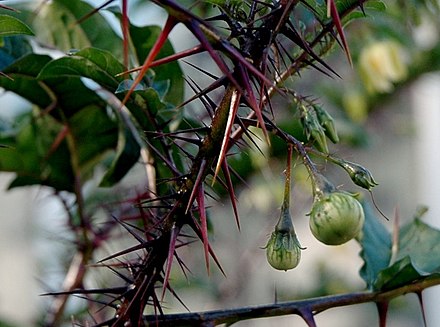Solanum
Androcera Nutt.
Aquartia Jacq.
Artorhiza Raf.
Bassovia Aubl.
Battata Hill
Bosleria A.Nelson
Ceranthera Raf.
Cliocarpus Miers
Cyphomandra Mart. ex Sendtn.
Diamonon Raf.
Dulcamara Moench
Lycopersicon Mill.
Melongena Mill.
Normania Lowe
Nycterium Vent.
Ovaria Fabr.
Parmentiera Raf. (non DC.: preoccupied)
Petagnia Raf.
Pionandra Miers
Pheliandra Werderm.
Pseudocapsicum Medik.
Scubulus Raf.
Solanastrum Fabr.
Solanocharis Bitter
Solanopsis Bitter
Triguera Cav.
Solanum is a large and diverse genus of flowering plants, which include three food crops of high economic importance: the potato, the tomato and the eggplant (aubergine, brinjal). It also contains the nightshades and horse nettles, as well as numerous plants cultivated for their ornamental flowers and fruit.
Solanum species show a wide range of growing habits, such as annuals and perennials, vines, subshrubs, shrubs, and small trees. Many formerly independent genera like Lycopersicon (the tomatoes) and Cyphomandra are now included in Solanum as subgenera or sections. Thus, the genus today contains roughly 1,500–2,000 species.
The generic name was first used by Pliny the Elder (AD 23–79) for a plant also known as strychnos, most likely S. nigrum. Its derivation is uncertain, possibly stemming from the Latin word sol, meaning "sun", referring to its status as a plant of the sun.[3]
The species most commonly called nightshade in North America and Britain is Solanum dulcamara, also called bittersweet or woody nightshade. Its foliage and egg-shaped red berries are poisonous, the active principle being solanine, which can cause convulsions and death if taken in large doses. The black nightshade (S. nigrum) is also generally considered poisonous, but its fully ripened fruit and foliage are cooked and eaten in some areas. The deadly nightshade (Atropa belladonna) is not in the genus Solanum, but is a member of the family Solanaceae.
Most parts of the plants, especially the green parts and unripe fruit, are poisonous to humans (although not necessarily to other animals), but many species in the genus bear some edible parts, such as fruits, leaves, or tubers. Three crops in particular have been bred and harvested for consumption by humans for centuries, and are now cultivated on a global scale:


.jpg/440px-Solanum_palinacanthum_(cropped).jpg)
